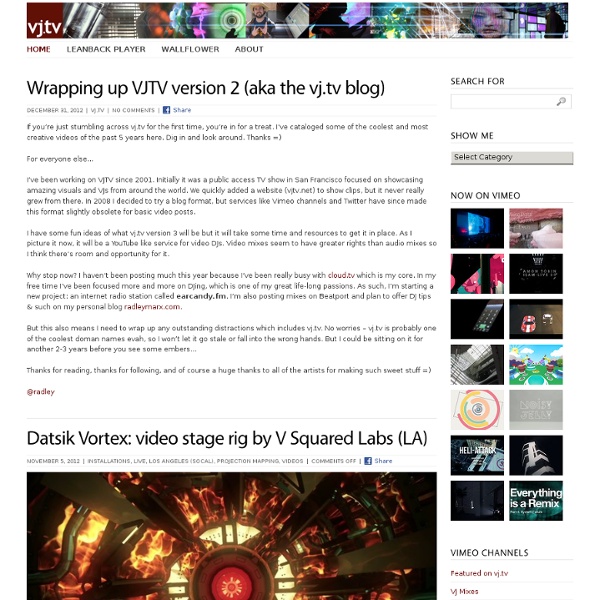



15 Amazing Interactive Installations Feb 21 2010 By Romain Colin Here is something for a slow lousy Sunday: in this inspirational round-up we feature some outstanding interactive installations that explore the art of interaction between environment, users and machines. Extraordinary artworks. Take a look at 15 beautiful examples of interactive installations: experiments, motions, applications and more. Installations / Applications Klaus Obermaier 1.3 mb / 27 x 20 cm 1.5 mb / 19 x 14 cm 1.5 mb / 27 x 19 cm 10 Best Software for Visual Performance Artist 10 Best Software for Visual Performance Artist The task of selecting software for live audio-visual performances can become overwhelming, given the wide variety of solutions that are available. As is true of choosing anything, you need to understand what you need. You then take a look at what is available. Once again as with most other products, there are features offered that you may not comprehend completely.
How To Project On 3D Geometry Russian | French | Italian Note that due to the manual nature of the described approach your results will not be perfect, but can be quite good depending on your patience. Introduction PIXnMIX VJ Info mixers Edirol V4, V1, LVS-400 Korg KrossFour Panasonic MX50 (out of production), MX30 (out of production) MX20 Allen + Heath Xone 9:2 - DJ mixer with MIDI output which can control edirol video mixers for AV mixing. players Pioneer DVJ-X1 - Worlds first DVD scratching deck. Pioneer DVD-V7300D - Advanced professional DVD player with computer control interface. Deltron Cinema Disk - Portable MPEG2 hard disk based player.
VPT 6.0 VPT 8 by HC Gilje, released may 2018. Video Projection Tool (VPT) is a free multipurpose realtime projection software tool for Mac and Windows. VPT 7 was downloaded over 100000 times, so in spite of a lot of other options available VPT still is popular. Among other things it can be used for projecting mapping on complex forms, adapt a projection to a particular space/surface, combine recorded and live footage, for multiscreen HD playback, for interactive installations using arduino sensors or camera tracking ++. VPT is very flexible in terms of control, with presets and a built in cue list, as well as control over almost every single parameter using OSC, midi, serial communication, built in LFOs and ArtNet.
P V P What is ProVideoPlayer™? Order PVP2 Now! Since its original release 8 years ago, PVP has been used by organizations around the world to create video walls, digital signage, dynamic staging and much more. www.dataton.com WATCHOUT is wowing visitors with the world's largest high definition video wall at Suntec, Singapore. The Big Picture, the 60 metre wide, 15 metre tall display located inside the main entrance at Suntec is the proud recipient of the Guinness World Records title as the 'Largest High Definition Video Wall'. A WATCHOUT system manages the dazzling and dynamic content. Expo 2012 Yeosu, Korea, was the biggest single-site project of the year with WATCHOUT employed in numerous pavilions and events. “We are extremely pleased to see that many pavilions chose WATCHOUT because of the genuine reputation we created for our products and services during the world expo in Shanghai two years ago,” says Fredrik Svahnberg, Marketing Director, Dataton.
Akten - Personal projects, artworks, research and collaborations - Reincarnation Audio-visual installation 1ch HD video, 2ch sound Duration: 04:27 Dimensions: variable Created with custom software tracking the motion of the dancers and generating these visuals, abstract layers containing subtle hints of human forms and motion. When the clip starts, you probably won’t recognize a human shape at first, but your eyes and mind will be searching, seeking mental connections between abstract shapes and recognizable patterns, like looking for shapes in clouds. You’ll be questioning what you see, is that it? is it sitting?
Max (Wikipedia) Max is a visual programming language for music and multimedia developed and maintained by San Francisco-based software company Cycling '74. During its 20-year history, it has been used by composers, performers, software designers, researchers, and artists for creating recordings, performances, and installations. The Max program itself is modular, with most routines existing in the form of shared libraries. An API allows third-party development of new routines (called "external objects"). As a result, Max has a large user base of programmers not affiliated with Cycling '74 who enhance the software with commercial and non-commercial extensions to the program.